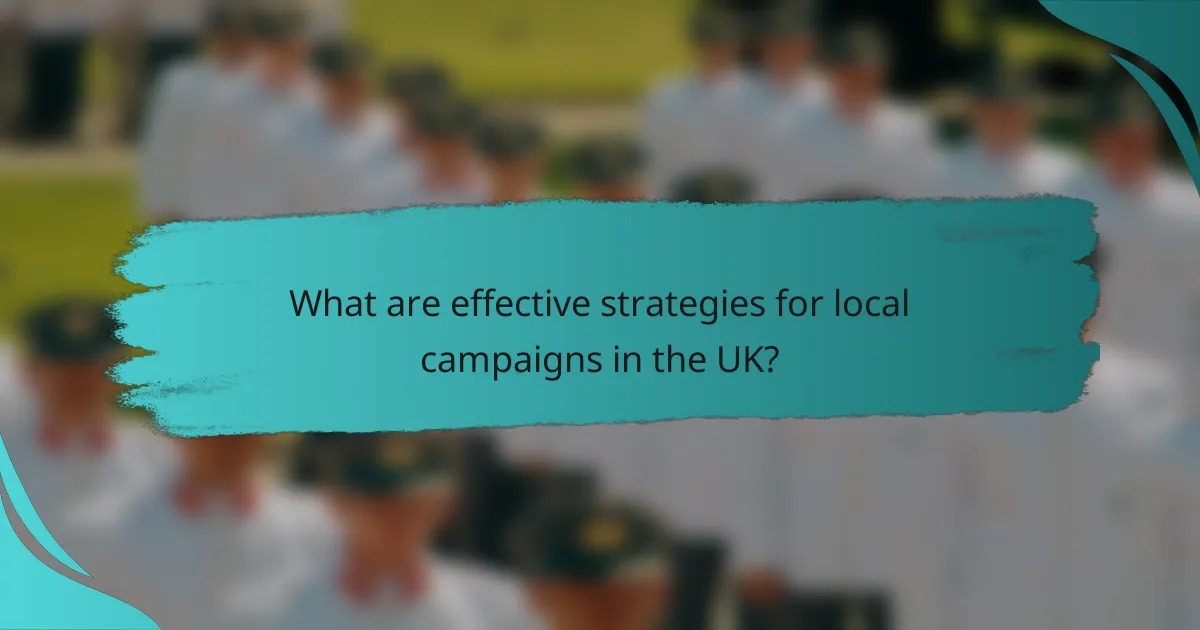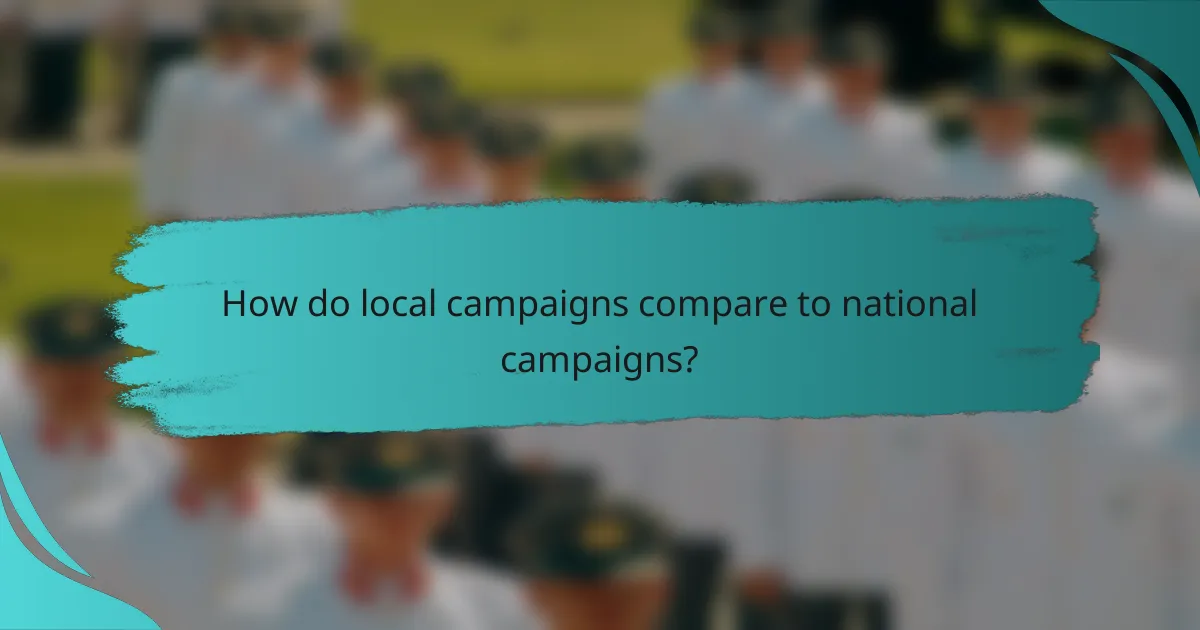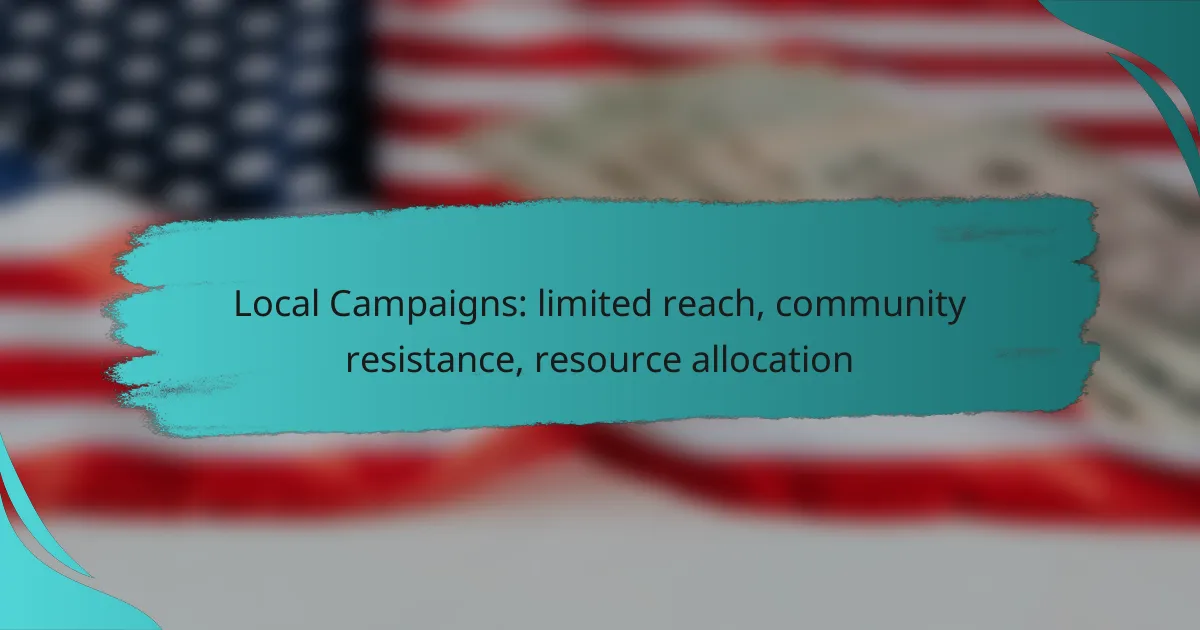Local campaigns frequently face challenges such as limited reach, community resistance, and resource constraints, which can impede their effectiveness. To overcome these obstacles, successful strategies involve engaging the community, collaborating with local businesses, and utilizing social media to enhance visibility. Additionally, careful resource allocation ensures that efforts are focused on the most impactful initiatives, ultimately leading to better engagement and outcomes.

What are effective strategies for local campaigns in the UK?
Effective strategies for local campaigns in the UK focus on engaging the community, utilizing local influencers, and leveraging social media to maximize reach and impact. By fostering relationships within the community and collaborating with local businesses, campaigns can overcome limited reach and resistance.
Targeted community engagement
Targeted community engagement involves identifying and connecting with specific groups within the local population. This can be achieved through surveys, focus groups, or community meetings to understand their needs and concerns.
Consider using tailored messaging that resonates with different demographics. For instance, campaigns aimed at younger audiences might employ more digital outreach, while older groups may prefer traditional methods like flyers or local newsletters.
Utilizing local influencers
Local influencers can significantly amplify a campaign’s message by leveraging their established trust and rapport within the community. Collaborating with individuals who have a strong local following can help to reach audiences that might otherwise be resistant.
Identify influencers who align with your campaign’s values and objectives. This could include local bloggers, social media personalities, or community leaders who can share your message authentically.
Leveraging social media platforms
Social media platforms are essential tools for local campaigns, allowing for real-time interaction and feedback from the community. Platforms like Facebook, Instagram, and Twitter can be used to share updates, gather opinions, and promote events.
Focus on creating engaging content that encourages sharing and interaction. Use local hashtags and geo-tagging to increase visibility among community members. Regularly monitor engagement metrics to adjust strategies as needed.
Participating in local events
Participation in local events is a powerful way to build visibility and foster relationships within the community. This could include fairs, markets, or charity events where you can set up a booth or sponsor activities.
Engage with attendees by offering informative materials, free samples, or interactive activities. This direct interaction can help to humanize your campaign and create lasting connections.
Collaborating with local businesses
Collaborating with local businesses can enhance a campaign’s credibility and reach. Local shops and services often have established customer bases that can be tapped into for mutual benefit.
Consider co-hosting events, offering joint promotions, or cross-promoting on social media. This not only helps to share resources but also strengthens community ties, making your campaign more relatable and accepted.

How can resource allocation improve campaign effectiveness?
Resource allocation can significantly enhance campaign effectiveness by ensuring that funds, time, and personnel are directed towards the most impactful strategies. By prioritizing resources based on data and community needs, campaigns can achieve better engagement and outcomes.
Budget prioritization
Budget prioritization involves allocating funds to the most effective channels and activities that align with campaign goals. For example, if social media engagement is proven to yield high returns, more budget should be directed there rather than to less effective methods. Regularly reviewing and adjusting budget allocations based on performance metrics can maximize impact.
Consider setting aside a portion of the budget for testing new approaches. This allows for flexibility and adaptation to community feedback, ensuring funds are used where they can generate the best results.
Data-driven decision making
Data-driven decision making relies on analyzing relevant metrics to guide resource allocation. Collecting data on community preferences, engagement rates, and campaign performance helps identify which strategies are working and which are not. Tools like surveys and analytics platforms can provide valuable insights.
Utilizing data can also help in forecasting potential outcomes of different resource allocations. For instance, if historical data shows that targeted ads lead to higher conversion rates, allocating more resources to that channel can be justified.
Efficient use of marketing tools
Efficient use of marketing tools ensures that resources are not wasted on ineffective strategies. Leveraging automation tools can streamline processes such as email marketing and social media posting, allowing teams to focus on strategy and engagement. For example, using a customer relationship management (CRM) system can help track interactions and optimize outreach efforts.
Additionally, consider integrating tools that provide real-time analytics. This allows for quick adjustments based on performance, ensuring that resources are continuously aligned with campaign goals. Regular training on these tools can enhance team efficiency and effectiveness.

What are common challenges faced in local campaigns?
Local campaigns often encounter challenges such as limited reach to the target audience, community resistance, and resource constraints. These obstacles can hinder the effectiveness of initiatives aimed at engaging local populations.
Limited reach to target audience
Limited reach occurs when campaigns fail to effectively connect with their intended audience. This can result from factors like inadequate marketing strategies or a lack of understanding of community demographics.
To improve reach, campaigns should utilize local media channels, social media platforms, and community events. Engaging local influencers can also help amplify the message and attract a broader audience.
Community resistance to campaigns
Community resistance can arise from skepticism or opposition to the campaign’s goals or methods. This may be due to past negative experiences with similar initiatives or a lack of trust in the organizations involved.
Building relationships with community leaders and stakeholders is crucial for overcoming resistance. Actively involving residents in the planning process can foster a sense of ownership and increase acceptance of the campaign.
Resource constraints
Resource constraints refer to limitations in funding, personnel, or materials that can impede campaign execution. Many local campaigns operate on tight budgets, making it challenging to implement comprehensive strategies.
To address resource limitations, campaigns should prioritize essential activities and seek partnerships with local businesses or organizations for support. Utilizing volunteers can also help stretch limited resources while engaging the community in meaningful ways.

How to measure the success of local campaigns?
Measuring the success of local campaigns involves assessing various metrics that reflect engagement, conversion, and community sentiment. By analyzing these factors, you can determine the effectiveness of your outreach and make informed adjustments to improve future efforts.
Tracking engagement metrics
Engagement metrics are crucial for understanding how well your local campaign resonates with the community. Key indicators include social media interactions, event attendance, and website traffic originating from local sources. Aim for a mix of quantitative data, such as likes and shares, alongside qualitative feedback from participants.
Consider using tools like Google Analytics to track website visits and social media analytics platforms to measure engagement rates. A good benchmark for social media engagement is often around 1-3% of your audience, but this can vary by platform and campaign type.
Analyzing conversion rates
Conversion rates indicate how effectively your campaign translates engagement into desired actions, such as sign-ups, donations, or purchases. To calculate this, divide the number of conversions by the total number of visitors or participants, then multiply by 100 to get a percentage. A conversion rate of 2-5% is generally considered effective for local campaigns.
Focus on optimizing your calls to action and ensuring that your messaging aligns with community interests. A/B testing different approaches can help identify what resonates best with your audience, leading to higher conversion rates.
Gathering community feedback
Community feedback is essential for gauging the impact of your local campaign and identifying areas for improvement. Utilize surveys, focus groups, and social media polls to collect insights directly from participants. Aim for a response rate of at least 10-20% to ensure your data is representative.
When designing feedback mechanisms, keep questions clear and concise. Ask about specific elements of the campaign, such as messaging effectiveness and overall satisfaction. This feedback can guide future campaigns and help build stronger community relationships.

What are the prerequisites for launching a local campaign?
Launching a local campaign requires a clear understanding of the community’s needs, effective resource allocation, and strategies to overcome potential resistance. These prerequisites ensure that the campaign resonates with the target audience and achieves its objectives.
Understanding local demographics
Understanding local demographics is crucial for tailoring your campaign to the community’s specific characteristics. This involves analyzing factors such as age, income levels, education, and cultural backgrounds to identify the most relevant messaging and outreach methods.
For example, a campaign aimed at younger audiences may leverage social media platforms, while one targeting older demographics might focus on traditional media like newspapers or community events. Gathering demographic data can often be done through local government resources, surveys, or community organizations.
Conducting market research
Conducting market research helps to gauge community sentiment and identify potential barriers to your campaign. This process can include surveys, focus groups, and interviews to gather insights on public opinion, preferences, and concerns related to the campaign’s goals.
Effective market research should also assess competitors and similar initiatives in the area. Understanding what has worked or failed in the past can inform your strategy and help allocate resources more effectively, ensuring that your campaign is both relevant and impactful.

How do local campaigns compare to national campaigns?
Local campaigns typically have a more limited reach than national campaigns, focusing on specific communities or regions. While they can foster strong community engagement, they often face challenges such as resource allocation and resistance from local stakeholders.
Limited Reach
Local campaigns are designed to target specific geographic areas, which inherently limits their audience compared to national campaigns. This localized focus can lead to deeper connections with community members but may restrict overall visibility and impact.
For example, a campaign promoting a local business may only reach residents within a few miles, while a national brand can engage millions across the country. This limited reach necessitates tailored messaging that resonates with the local audience.
Community Resistance
Community resistance can pose significant challenges for local campaigns, as stakeholders may be skeptical of outside influences or changes. Campaigns must navigate local sentiments and establish trust to gain acceptance.
To mitigate resistance, campaign organizers should involve community members in the planning process, ensuring their voices are heard. Engaging local leaders and influencers can also help build credibility and support.
Resource Allocation
Resource allocation is critical for the success of local campaigns, as they often operate with limited budgets and manpower. Effective planning involves prioritizing resources to maximize impact within the community.
Campaigns should assess local needs and allocate funds to the most effective channels, such as social media, local events, or partnerships with community organizations. Regular evaluation of resource distribution can help identify areas for improvement and ensure that efforts align with community goals.
